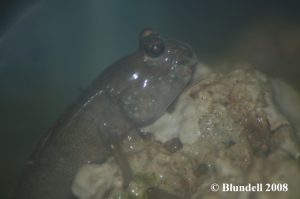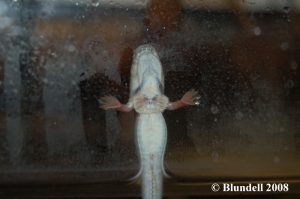Even before I started college I was working with marine fishes. My interest in breeding and raising fish only grew with time. I think it was during my first year of college while working in an aquaculture lab that I discovered my passion wasn’t in the process of raising fishes, but it was in studying the real oddities and outliers of genetic differentiation. “Duping” fish into spawning, computer models, form & function, these were fascinating challenges to me. So while most breeders love the gobies because of their relative-ease in captive propagation, I was turned off by gobies because they were boring (at least to me).
There are exceptions to this (as with everything). I am still fascinated by Goby/Shrimp pairing (look for a future article on this), Goby diversification, and of course some of those very unique fishes… the mudskippers.
Introduction
Mudskippers are amazing. These fishes are in the family Gobiidae (Gobies) and they truly represent the far reaches of adaptation. They live an amphibious lifestyle where ocean meets shore. Truly fascinating, and under appreciated in the hobby.
Mudskippers are found along coastal areas of the Info-Pacific (and Africa) where they inhabit tidal areas and mangrove systems. They can be found in waters ranging from near fresh to full strength sea water.
Mudskippers have a type of cutaneous breathing which means they can exchange dissolved gases across their skin. This allows them to breathe while out of water. They also possess gills which allow them to breathe while in the water. They spend (about) half their time underwater and half their time out of water. This is a very rare trait as evolution typically has strong selective pressure favoring locomotion patterns for either water or land, but rarely for both. It has been my experience that certain individuals will defend a territory in the water and spend most of their time there, while other individuals will defend a territory out of the water and spend most of their time there.
That bring up an important issue… mudskippers are territorial. I’d recommend about one per 10 gallons of total aquarium size (not water volume).
Captive Care
These fishes (about 20 species) are awesome hobby fish, well suited for captivity. They are easy to feed, have fascinating habitats, collected in low numbers, disease resistant, and are simply fun to care for.
Water Conditions
I prefer to keep my mudskipper system at full saltwater strength. However these fish are also found in brackish water. Before adding them to your system it is important to find what salinity your supplier uses, and slowly adjust them to your system. I’ve seen success in this by starting a new system to match the suppliers water, and then bringing up the entire system over a few week period.
Feeding
Feeding Mudskippers is a piece of cake. They are voracious. You can feed them small insects and terrestrial food like crickets. However this is completely unnecessary. Mudskippers readily take frozen foods like blood worms, mysis, brine shrimp, etc.
Tank Design
Tank design is very important for mudskippers. This is almost reason enough to get these fish. If you are a hobbyist like me you are always looking for a reason to set up a new kick-ass unique tank anyway. The main item I would suggest here is to have an aquarium with extra space above the water. These fish love to climb up a couple inches on the glass. I’ve seen tanks with only 1 inch above the water line that never had mudskippers escape. However I prefer several inches, better safe than sorry.
These fish would do well in tanks with surges, dump buckets, and other tidal water flow. They also do well in Paladarium or Viquarium systems.
These photos show some successful mudskipper set ups. Even though the 20 gal only has about 1inch above the water surface the skippers have never escaped. The 40 gal aquarium allows for tall mangrove systems.
Conclusion
Mudskippers are awesome. They are one of the most intriguing forms of evolution. Not only are they amazing animals but they are well suited for captive care. Their habitats are fascinating and are underappreciated in the hobby. For hobbyists looking for something truly inspiring and educational, I recommend looking into mudskipper care.
















0 Comments